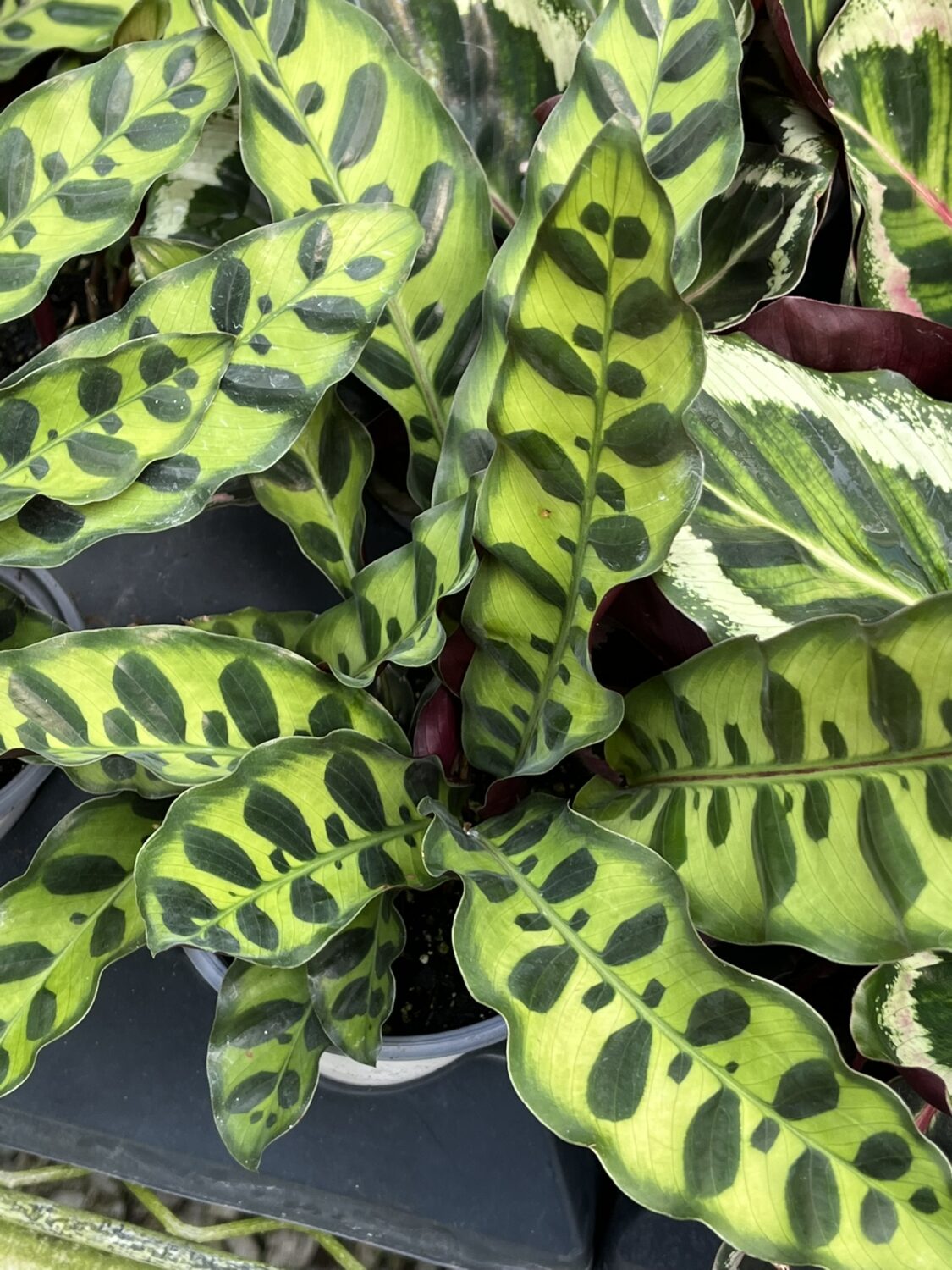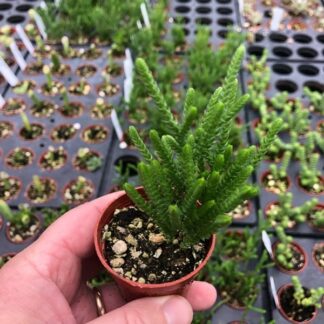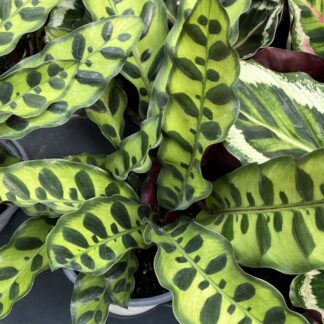Description
Calathea lancifolia: How to Grow and Care for the Rattlesnake Plant
If you’re looking for a houseplant that’s both pet-friendly and eye-catching, let me introduce you to the Calathea lancifolia, more playfully known as the Rattlesnake Plant. With its long, wavy leaves and bold patterns, this tropical beauty practically begs for a spotlight in your home. But here’s the best part—it’s not just about looks. The Rattlesnake Plant also helps clean the air, and it won’t harm your curious pets or little ones.
So, if you’re dreaming of bringing the jungle indoors but want something that’s easy to live with, keep reading. I’m going to walk you through everything you need to know to help your Calathea thrive—from light and soil to humidity and pests.
Let’s get into it.
Meet the Rattlesnake Plant
At first glance, Calathea lancifolia looks like it stepped out of a rainforest painting. Its long, narrow leaves feature light green centers with deep green brushstrokes that resemble the markings of—you guessed it—a rattlesnake. Turn the leaf over and you’ll find a deep purple underside. This dramatic color contrast gives the plant an almost magical look.
Originally from the warm and humid rainforests of Brazil, this tropical plant is a member of the Marantaceae family, often called “prayer plants.” Why? Because they gently raise and lower their leaves in rhythm with the day. It’s like they’re breathing with your home.
And here’s something even more wonderful: Calathea lancifolia is non-toxic to both cats and dogs, which makes it a dream plant for households with pets.
Getting Started: Planting and Propagation
Calathea lancifolia is not grown from seed very often. Most people propagate it by division, and it’s really not too hard!
Propagation by division (best in spring or summer):
-
Gently remove the plant from its pot.
-
Look for natural clumps or offshoots.
-
Separate the roots using your hands or a clean knife.
-
Plant each clump in its own small pot with fresh, moist soil.
-
Place in a warm, humid spot with indirect light.
That’s it! You’ll have new plants in no time.
Light: Bright, But Not Direct
This plant loves bright, indirect light—think of what it gets in a rainforest under the canopy of trees.
-
Best indoor spot: Near an east- or north-facing window.
-
Too much sun? If you have only west- or south-facing windows, try using a sheer curtain to filter the light.
-
Too little light? The patterns on the leaves may fade, and growth will slow.
Avoid harsh, direct sun. The leaves can scorch and lose their vibrant color. Calathea likes to be pampered, not sunburned.
Soil: Moisture-Holding, But Well-Draining
The right soil will make a huge difference. Calathea likes moisture, but it hates soggy feet. Here’s a mix that works like magic:
-
2 parts high-quality potting soil
-
1 part perlite (helps drainage)
-
1 part peat moss or coconut coir (holds moisture)
You can also use a mix designed for African violets, which has a similar texture.
Watering: Consistency Is Key
Calathea can be a bit fussy about water, but don’t worry—once you get the rhythm, it’s easy.
Watering tips:
-
Check the top inch of soil. If it’s dry, it’s time to water.
-
Use filtered, rain, or distilled water. Tap water often has chlorine and fluoride, which can brown the leaf tips.
-
Keep soil evenly moist, especially in spring and summer.
-
In winter, cut back slightly, but never let it dry out completely.
Overwatering leads to yellow leaves, while underwatering causes crispy edges. Watch your plant—it’ll tell you what it needs.
Temperature & Humidity: Tropical Vibes Only
This plant comes from the jungle. It likes it warm and damp, just like home.
-
Ideal temperature: 65–80°F (18–27°C)
-
Avoid: Drafts, cold windows, air conditioners, or heaters.
-
Humidity: Loves it! Aim for 50% or higher.
How to boost humidity:
-
Place a tray of water with pebbles under the pot.
-
Mist regularly (but not too much).
-
Use a humidifier, especially in winter when indoor air gets dry.
If your Calathea’s leaves are curling, it’s likely craving more moisture in the air.
Feeding: Small Meals, Not Buffets
Feed your Calathea during the growing season—spring and summer. Use a balanced, water-soluble fertilizer at half strength every 4–6 weeks.
Important tips:
-
Don’t overfeed. It can cause salt buildup in the soil.
-
Flush the soil every few months with plain water to clear out excess salts.
Skip the feeding in fall and winter—your plant is resting then.
Pruning and Leaf Care: Keep It Looking Fresh
Your Rattlesnake Plant doesn’t need much pruning, but a little grooming now and then keeps it happy.
-
Remove yellow or brown leaves using clean scissors.
-
Wipe the leaves with a damp cloth to remove dust.
-
Rotate the pot every couple of weeks to keep it growing evenly toward the light.
This is a great time to check for pests, too.
Watch Out for Pests and Problems
Calathea lancifolia is pretty resilient, but it can attract spider mites, mealybugs, or aphids. Most of the time, you can catch the problem early.
Pest signs:
-
Fine webbing
-
Sticky residue
-
Leaves curling or becoming discolored
What to do:
-
Wipe the leaves with a soft cloth and soapy water.
-
Neem oil spray is safe and effective.
-
Improve air circulation and avoid overwatering to keep pests and mold away.
Repotting: Give It Room to Grow
Your Calathea will need a new pot every 1–2 years, usually in the spring.
Signs it’s time to repot:
-
Roots growing out of the drainage holes
-
Water runs right through the pot
-
It just seems cramped
Steps to repot:
-
Gently remove the plant.
-
Shake off old soil.
-
Inspect the roots—trim any that look mushy.
-
Replant in a slightly larger pot with fresh soil.
-
Water lightly and keep it in its usual light and humidity.
Styling and Decorating With Calathea
Let’s not forget one of the best parts—this plant is gorgeous!
Here are some fun ideas:
-
Use a decorative ceramic pot that complements the purple on the leaf undersides.
-
Place on a side table or plant stand to elevate it.
-
Pair with other tropical plants like ferns or monsteras for a full jungle look.
Why You’ll Love It
There’s just something special about the Rattlesnake Plant. It’s not loud or flashy—it’s elegant, unique, and quietly stunning. And once you get to know its rhythm, it becomes one of the easiest plants to care for.
To recap:
✅ Pet- and kid-friendly
✅ Stunning, patterned foliage
✅ Air-purifying
✅ Compact and easy to style
✅ A little piece of the rainforest, right in your home
So go ahead—give your indoor garden a bold new look with Calathea lancifolia. It’s beautiful. It’s safe. And it just might become your new favorite plant.
Want to add more tropical charm to your collection? Check out our full guide to prayer plants, ferns, and air-purifying companions. Your home can be a lush, leafy paradise—all it takes is the right plant and a little love. 🌿💚





